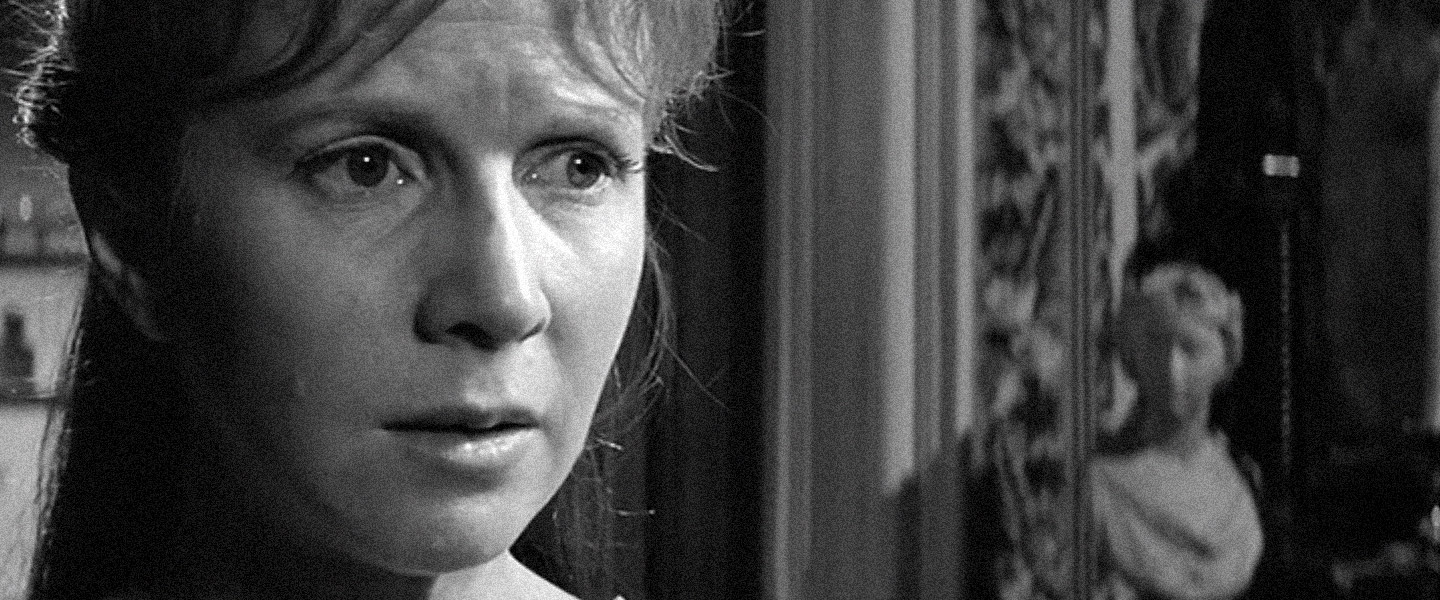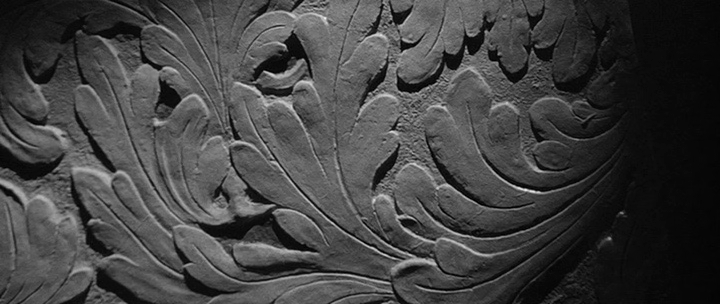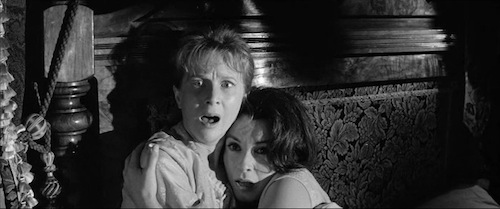This October, Deadshirt staff revisits some of our favorite horror movies from a variety of subgenres and breaks down what makes them so memorable, so clever, and so terrifying. This week: The mother of all haunted house movies, The Haunting.
I’ve been a fan of Robert Wise’s The Haunting since my mother first showed me the film as a child. I recently showed the film to a group of friends who’d never seen it and, here’s the thing, they were scared of it. Genuinely scared too, way beyond “laughing with your friends at horror movie” but actually, for-real creeped out. Which, for a fifty-plus year old movie, really speaks to just how well crafted it is.
An evil old house, the kind some people call haunted, is like an undiscovered country waiting to be explored. Hill House had stood for 90 years and might stand for 90 more. Silence lay steadily against the wood and stone of Hill House, and whatever walked there… walked alone.
The Haunting, adapted from Shirley Jackson’s novel The Haunting of Hill House, follows Eleanor “Nell” Lance (Julie Harris), a lonely woman invited to participate in an investigation of paranormal activity with several others by Dr. John Markway (Richard Johnson) at Hill House, a sprawling stone mansion whose owners have all died under strange or mysterious circumstances. Deaths that happen in Hill House are never murders, just accidents or suicides. It’s often unclear whether it’s one or the other in some cases.
The Haunting is in many ways the original “living” haunted house movie, and its influence on films such as The Shining is irrefutable: Hill House’s DNA can be found in The Overlook Hotel’s impossible geometry and ability to cruelly manipulate its inhabitants. Hill House is treated as just as much a malevolent entity as it is a location. The estate is filled with faces; carved into the woodwork of walls, into statues, even into doorknobs. Despite being “alive,” Hill House’s desires or goals are unknowable to film’s characters and to the viewer.
Hill House, and Eleanor’s evolving relationship with it, are central to The Haunting. Eleanor is ostensibly homeless when we meet her, paying rent to her obnoxious sister and brother-in-law to sleep in their living room. When she’s invited to participate in Markway’s experiments (because of her history with psychic phenomena, though she doesn’t know this at the time), she jumps at the chance. For Eleanor, Hill House is a place where she can belong, a place where she’s welcome. Eleanor is a woman haunted by guilt following the death of her mother, revealed later to be incredibly similar to the death of one of Hill House’s prior owners, Abigail Crain. Upon arriving, the first thing Eleanor is scared by is her own reflection in a mirror. This is, in a nutshell, the power of The Haunting as a film: it makes you scare yourself.
SPOILERS AHEAD.
Suppose the haunting is all in my mind?
Many of The Haunting‘s scares come from impressive camerawork, such as a roller coaster “drop” down the spiral staircase in the library or the staccato trumpets during an intense close up on Eleanor when she’s overcome by the house. The supernatural elements of the film are vague and subtle. Cold spots, moments of premonition. Doors that bend and shut or lock and unlock seemingly at will. Are the film’s supernatural encounters genuine or are they the result of the house’s wrong angles and human panic? The Haunting tricks us into scaring ourselves because it lacks a physical monster. We’re forced to extrapolate what is banging and scratching against the other side of the wall of Eleanor’s bedroom, or who is laughing unseen in the hallways. The film’s biggest set piece, a wooden door bulging inward in defiance of the laws of physics, is absolutely terrifying because it’s The Haunting‘s only real special effects sequence. The viewer can’t logically reconcile what they’re seeing with the rest of the film, which appears to exist in a very realistic world.
The power of The Haunting is also in part due to very believable performances from Harris and Claire Bloom, who plays the urbane and sarcastic Theodora. Theodora is a fascinating character; her coded status as a lesbian isn’t subtle and her relationship with Eleanor swings wildly between pseudo-intimacy and malicious teasing. Theodora’s outward affection and desire for Eleanor confuses and upsets her. When Eleanor screams at Theodora that she’s “the monster of Hill House” after she cruelly mocks her, she’s right in a sense. Most of the movie’s conflict comes from group sniping and power dynamics: Theodora’s almost predatory preoccupation with Eleanor, Eleanor’s one-sided crush on Dr. Markway, Markway’s creepily paternal attitude toward his psychically-inclined pupils.
The house wants me. Mrs. Markway can’t satisfy it like I can.
Terrified of returning to the outside world, Eleanor develops a sinisterly symbiotic relationship with Hill House. Mysterious graffiti appears on a wall that reads “ELEANOR COME HOME.” As Theodora posits, maybe the house sees her as a kindred spirit. When Dr. Markway’s wife (a pre-James Bond appearance from Lois Maxwell) comes to stay at the house, Eleanor descends into madness. “I’m home. I’m home. I’m home.” she thinks to herself. Eleanor resents Grace Markway not only because of her relationship with her husband but because she’s afraid Hill House has chosen Grace over her. Distraught, Eleanor attempts suicide at the top of an unsteady spiral staircase, mirroring a suicide that occurred in the house decades earlier, but is rescued by Dr. Markway, who orders her to leave Hill House for her own safety. Fleeing in her car, Eleanor is seemingly overtaken by Hill House and forced to crash into a tree on the property, the same tree that once killed Hugh Crane’s wife in a carriage accident.
“The house has what it wants. For a while.” laments Dr. Markway as he stands over Eleanor’s corpse. The Haunting‘s final chill is in the realization that our heroes lose to the immortal, indestructible Hill House, further compounded by post-mortem narration from a ghostly Eleanor; “Hill House has stood for ninety years and might stand for ninety more. Within, walls continue upright, bricks meet, floors are firm, and doors are sensibly shut. Silence lies steadily against the wood and stone of Hill House. And we who walk here… walk alone.”
Come back next Friday for a look at another of our favorite horror movies.






